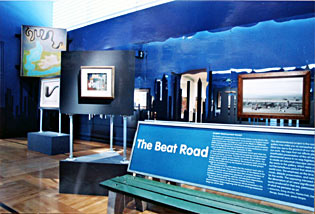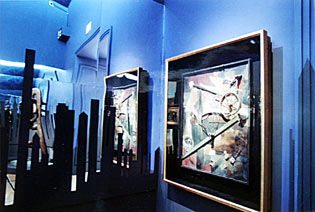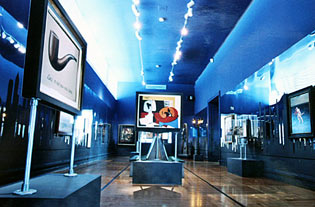 |
August
2003 volume 1, issue 2 |
| |
|
| Interview
with Peter Fend
|
"Imagination is an Instrument of Survival"
(continued 1 2
3 4 5 6
7 8)
Appendix #4: A student reinstallation at "Made In California: Now"[3], a structure by Michael Asher. I wanted to produce a project which gave high-school students an opportunity to arrange historical art objects in a way that they would prefer to experience them. To this end I structured
a situation which enabled the youths to meet twice a week at the museum,
to not only learn about the art objects in the gallery they would
be reinstalling but also to meet with different departments in the
museum to learn about their function.
The Beat Road, Student installation project. Photograph by Michael Asher. The limits the students had to remain within were as follows: 1) The artwork had to be safe wherever it was repositioned. The museum staff agreed not to stop any of the students decisions based upon museum or personal taste. On the other hand, they did expect the students to take responsibility for their decisions and to be able to justify them. Other than meeting with the students several times, I did not participate in their decision-making process. A facilitator who had experience in museum procedures met with them regularly. The student re-installation was in the Palmer Gallery.
It contained 19th century European artwork from the permanent collection.
One of the requirements in my proposal was that the students could
only use the pre-existing artworks that the curator had chosen, to
construct their own version of history. The Beat Road, Student installation project. Photograph by Michael Asher. This project sought another experimental approach to arts education. Having the youths reinstall the gallery constituted a direct way they could re-organize historical objects without being obliged to use museum parameters or a canonical historical narrative. When putting together the proposal I had no clue as to how the students would approach this task and if they did, what changes they would make and which ones they would keep of the curator’s presentation. If they did reinstall the gallery I was hoping for a result which might appear awkward or idiosyncratic in juxtaposition to the displays normally used in the museum. The purpose for this was to ask - could the disjunction caused produce a space of reflection on the museum’s display practice? And could this reflection go as far as introduce questions that institutional critique could not answer due to its sophisticated visual make-up? Also intrinsic to this project was the question - could the reduction of museum authority over the viewing be effected by non-expert installation designers? My work was the devising of this structure, allowing others to express themselves and interact with the museum. The final installation outcome was unpredictable. This was also a project whose critical effect could be measured immediately through its operation both in the public and within the museum bureaucracy. -Michael Asher
The Beat Road, Student installation project. Photograph by Michael Asher. |
||
|
|
|||




